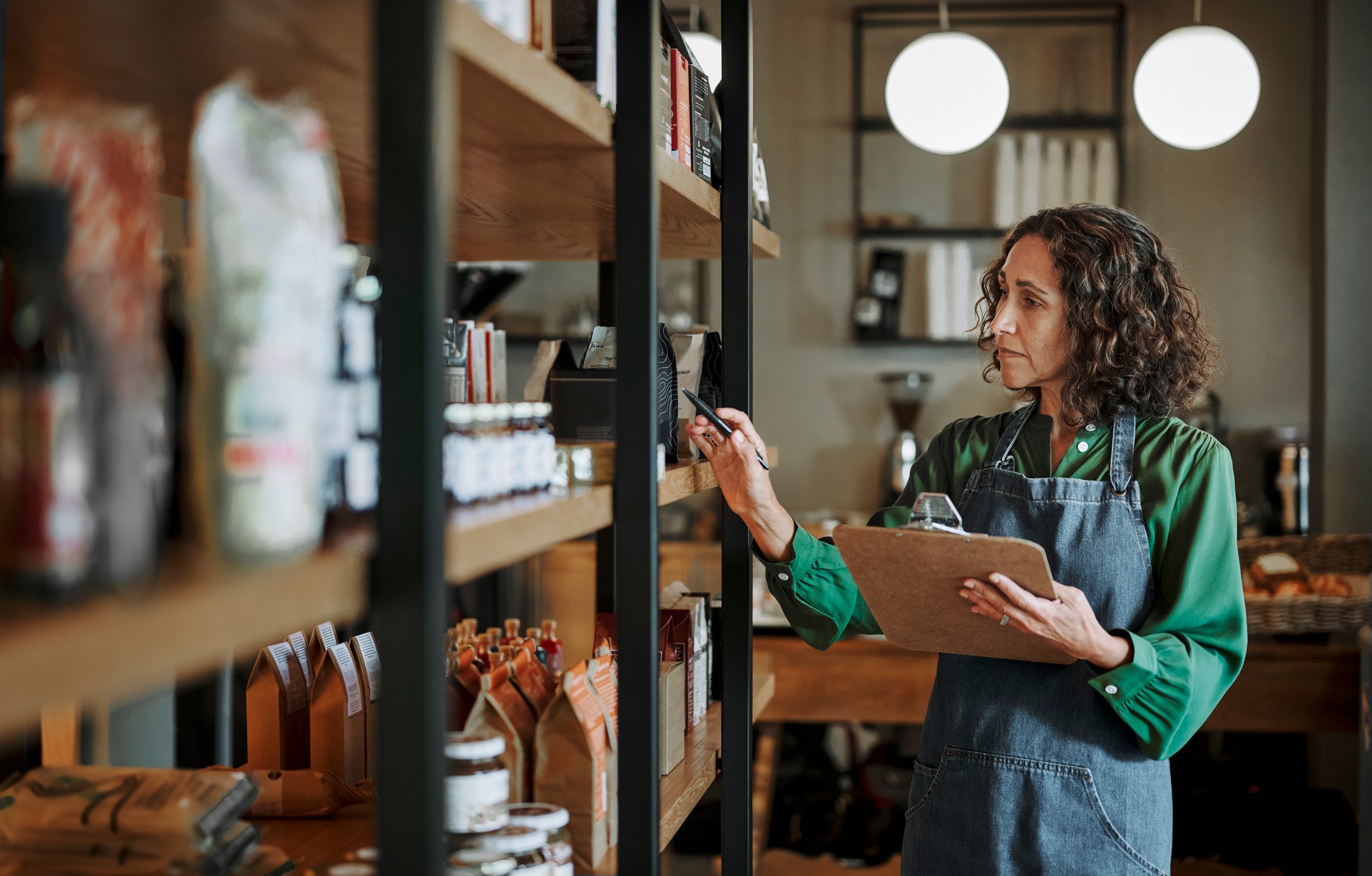Has it always been your dream to open a bakery? There’s no better-smelling office space than a bakery, that’s for sure. Starting a bakery is a lot like starting any business, but with a few extra special ingredients.
Follow these steps to get started.
1. Decide on a type of bakery.
Before you start working on your business plan, it’s good to decide what type of bakery you’ll open.
- Bakery cafes sell baked goods directly to customers, and also have a dining area for customers to stay and eat awhile.
- Counter service bakeries have a smaller front-of-house area than bakery cafes. Customers order baked goods to go from the counter, but there’s nowhere for them to sit and eat.
- Food truck bakeries are even smaller, transforming the counter into the pickup window of a food truck. Because food trucks are small, it’s common for these bakery owners to bake their goods ahead of time, whether at home or a rented kitchen.
- Specialty bakeries specialize in a specific category of baked goods, such as wedding cakes or gluten-free pastries.
- Wholesale bakeries sell to other businesses, as opposed to customers. Wholesale bakeries may start out selling to local coffee shops, but as they expand their partnerships into delis and restaurants, a larger commercial kitchen is required to house all the equipment they need to fill those orders.
- Home bakeries are becoming ever more popular, due to the growth of entrepreneurs like you. These bakers operate their bakeries out of their home, and sell their goods online or at farmers’ markets.
Starting a Bakery Business from Home
Home bakeries require significantly less startup capital than other types of bakeries, and there’s no expectation for you to be a graduate of Le Cordon Bleu. You can be a food blogger or baking aficionado who decided to share their recipes with the world.
Plus, people love supporting local bakers, no matter where “local” really is. You can set up an ecommerce website for your home bakery, and reach local-minded shoppers all over the country. Many home bakers choose to start out within a certain niche, such as gluten-free, or specialize in a certain type of baked good, such as cupcakes. This allows them to focus their marketing and be super-targeted with their advertising budget.
2. Draft a business plan for your bakery.
Every business needs a business plan. So step away from the KitchenAid for a moment and swap your whisk for pen and paper. Your business plan can help you lay out key details for your business, such as:
- Executive summary
- Bakery description
- Market analysis
- Organizational structure and management
- Product or service overview
- Marketing and sales strategy
- Financial plan and projections
3. Understand how much it costs to open a bakery.
We won’t sugarcoat it. It probably costs more than you think to open a bakery. Here’s a list of the typical bakery startup costs you’ll encounter:
- Commercial lease
- Business insurance
- Licensing and permits
- Business taxes
- Labor costs
- Utilities
- Ingredients
- Bakery equipment
- Point of sale system
- Website hosting
- Marketing and advertising
- Repairs and unexpected expenses
Several loans are available for bakery businesses, including SBA small business loans, equipment financing, or a business line of credit from your bank.
4. Rent space for your bakery.
If you’re operating a brick-and-mortar bakery, you need to find a commercial space you can rent. Counter service and cafe-style bakeries will want a central location that has good curb appeal, and is near their target demographic. Wholesale bakeries, on the other hand, can be located much farther from the city center.
When evaluating a commercial space, consider the area’s demographics, crime rate, and health or zoning regulations. You’ll want easy access for your customers (be they people or businesses), and, ideally, there won’t be any competitors closeby.
Even if you’re planning to start a bakery business from home, you may want to look into commissary kitchens so your bakery doesn’t take over your whole house!
5. Register your bakery business.
Do you have a name for your bakery? Double-check that it’s not trademarked or currently being used for a domain name.
Then, consult an attorney or accountant to choose a business entity for your bakery (sole proprietorship, general partnership, limited liability company, or corporation). Register your business name with the government and apply for a federal tax ID.
Congratulations — you just made your bakery an official business!
6. Secure the necessary permits and licenses.
Food-based businesses like bakeries are subject to lots of regulation. Familiarize yourself with the permits or licenses you’ll need based on your bakery type and anywhere else you plan to sell (such as farmers’ markets or festivals). Check with your local government and SBA office to learn more about getting a:
- City or county business license
- Food handler’s license
- Seller’s permit
- Catering license
- Fire department permit and inspection
- Kitchen health and safety inspection
Additionally, home bakers may want to review their homeowner association rules to ensure they’re allowed to operate a business from their home.
7. Invest in the equipment you need to start a bakery.
You’re the baker, so you already know the equipment you need to create your culinary masterpieces. But now that you’re a business, you’ll need to bake on a much larger scale. Here’s a look at some of the equipment you might need.
Baking equipment
- Ovens
- Bakeware
- Specialty baking, decorating, and pastry tools
- Commercial mixers and mixing bowls
- Sifters
- Trays
- Dough press
- Dough dividers, dockers, rounders, sheeters, and scales
- Flour sifters
- Refrigerator and freezer
- Proofing and holding cabinets
- Work tables
- Aprons
Cleaning equipment
- Three-compartment sink
- Hand washing stations
- Disposable gloves
- Cleaning supplies
Storage and display equipment
- Shelving
- Storage racks
- Dollies
- Carts
- Display cases (self-service vs. full-service, refrigerated vs. unrefrigerated)
- Packing boxes and containers
8. Create your bakery layout.
While you’re waiting for your equipment to arrive, you can get started designing your bakery floor plan.
Back-of-house floor plan
Every baker needs a well-designed kitchen. You’ll want separate sections for food storage, food prep, baking, and cleaning. Your layout should allow for a natural flow between these areas.
Front-of-house floor plan
If you’re opening a cafe or counter service bakery, you’ll also want to design an attractive front-of-house floor plan that shows off your baked goods, while ensuring a clear, logical flow for the hundreds of customers you expect to walk through the door.
You might organize your display cases in a straight line and have your counter on top, or you could place them around the walls for an angular setup. You could even place cases on the floor in a way that encourages customers to wind through them.
Whatever design you choose, put your best-sellers and fanciest items at eye level. Make sure to allocate ample space for ordering, pickup, and payment — and dining, if applicable.
9. Finalize your menu and prices.
Step one is figuring out what you want to sell, in what varieties and flavors, for launch. You can always grow your menu later.
As for pricing, this is where your market analysis from step 2 comes into play. You want to price your baked goods based on the local market, the niche you’re serving (high-end vs. affordable), and what you need to turn a profit. Calculate your monthly operating costs, and determine what you need to charge per item to break even. Then sprinkle on some profit.
10. Develop your branding.
When customers think of your bakery, how do you want them to feel? That’s your brand, and it should be consistent throughout all of your marketing materials — from the aprons your staff wears to the logo sticker on your to-go boxes.
Spin up a logo and color scheme for your bakery that tells the story of your bakery. Use this style guide for your packaging, brick-and-mortar decor, and website.
11. Start marketing.
Take a look at your competitors, or other bakers you admire. How do they get the word out about their business? Then, add your own creative twist. You might try:
- Posting signs and flyers in the neighborhood
- Buying ads in your local paper
- Creating a website
- Posting photos of your creations and videos of the baking process on social media
- Listing your bakery in local directories like Google My Business and Yelp
- Offering coupons for patrons of nearby businesses, homeowners, or your grand opening attendees
12. Hire staff.
The number of staff you’ll need to hire depends on your budget, type of bakery, and your expectations for launch. Counter-service and cafe bakeries will need front-of-house workers to handle orders and payments, as well as back-of-house workers to prep and bake your food. Depending on the size of your bakery, you can hire additional workers to bus and wash dishes, or prepare to-go packaging.
Soon you’ll be selling like hotcakes
You’re ready for your grand opening, and we hope it’s a success. As a reminder, here are the steps to take:
- Decide on a type of bakery.
- Draft a business plan for your bakery.
- Understand how much it costs to open a bakery.
- Rent space for your bakery.
- Register your bakery business.
- Secure the necessary permits and licenses.
- Invest in the equipment you need to start a bakery.
- Create your bakery layout.
- Finalize your menu and prices.
- Develop your branding.
- Start marketing.
- Hire staff.
Don’t forget to purchase a business owners policy. This package includes general liability, commercial property, and business interruption coverage — the three ingredients every bakery owner needs!











